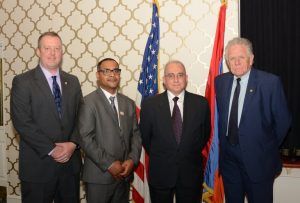Holy Translators St. Partev and Mesrop Mashtots

The Father Archimandrite became similar to Movses by bringing the Books of Law to Armenia, illuminating the generation of the sons of Torgom.
(psalm)
According to tradition, on that day St. Sahak and St. Mesrop met at the coast of Arax River. Every year on that day there was a grand celebration in Oshakan, which, as a rule, was accompanied by a pilgrimage to St. Mesrop’s tomb in Oshakan.
The second celebration of the Holy Translators is marked from October 3 to November 7.
In the late 4th century, Armenia was split in two. The western sector was under the dominance of Byzantine, while the eastern sector was under the dominance of Persia where King Vramshapuh of the Arshakuni had settled. In this sector, peace lasted for a comparably long time and it was at that favorable time when the Armenian alphabet was created, making it one of the most turning events in Armenian history. Catholicos St. Sahak, Archimandrite, St. Mesrop Mashtots, with support from King Vramshapuh, found the powerful and invincible tool for the preservation and development of the Armenian nation. The Armenian alphabet was created and laid the foundation for Armenian writing.
St. Sahak (348-438, Catholicos since 387) was the son of Patriarch, St. Nerses the Great and the descendant of the last male of the family of St. Gregory the Illuminator. Through St. Sahak’s efforts, King Vramshapuh helped St. Mashtots create the Armenian alphabet, and after its creation, helped establish schools and develop education. Patriarch St. Sahak and St. Mashtots became the founders of the literature to be translated into Armenian. St. Sahak and St. Mashtots and their students translated the Bible from Greek…and God started speaking Armenian.
St. Mashtots was born in 362 in the Hatsekats village of Taron province. According to Koryun, who wrote Mashtots’ biography, and other historians, Mashtots received a good education in Taron, left for Vagharshapat, held office as chief scholar at the palace and became a soldier. Despite his advancement in office, Mashtots left military service behind and became a clergyman, dedicating himself to studying the Holy Book and preaching.
Mashtots faced many hardships during his preaching in Goghtn province. Worshipping was in a foreign language, either Greek or Assyrian, and there were no copies of the Bible and church literature in Armenian. Despite the hardships, Mashtots, as Koryun testifies, led the people of Goghtn province to Christianity. However, the saint didn’t stop there. He started spreading the light of Christ in Armenia and abroad. But the Armenians didn’t have the chance to hear and understand the Christian doctrine in the native language. The two split sectors of Armenians were in danger of assimilation. Hellenism endangered the West, while the East was threatened by assimilation with the Persians.
According to the historian, Mashtots “was worried and thought of how he would find a solution to all that”. And he found the solution…
Upon his return to Vagharshapat, Mashtots was convinced that the Catholicos had the same thoughts, and King Vramshapuh also gave consent to their plan.
Hearing about the Danielyan letters, St. Mesrop immediately found and tried to use them, but in vain. Those letters couldn’t completely express the particularities of the Armenian language. After that, the saint was once again in his thoughts, and the two saints started looking for other ways. Seeing that he wouldn’t be able to implement his plan in Armenia, Mashtots decided to travel to Assyria. He and his students passed Edessia, Samosat and other sites to invent the Armenian alphabet.
According to Khorenatsi, the saint “relied on the prayer. He didn’t see a dream in his sleep or a vision while he was awake, but in his heart the eyes of his soul saw a Right Hand writing on a stone in a way that the stone maintained the trace of the lines on the snow. This not only appeared, but the details of all letters gathered in the saint’s mind like they would in a plate. Getting up after a prayer, he created the symbols, formulated the letters with Hropanos and matched the letters in Armenian with the sounds of Greek.
Then, they immediately started translating the Holy Book, starting from the book called “Fables”.
“TCHANACHEL ZIMASTUTYUN YEV ZKHRAT, IMANAL ZBANS HANTCHARO” (TO KNOW WISDOM AND INSTRUCTION, TO PERCEIVE THE WORDS OF UNDERSTANDING)-these were the first words written in Armenian by the first Armenian Teacher. This is also the saint’s first written precept to his students. Wisdom is christ, the thing is God, and the words of understanding are the Holy Book through which man will walk toward Truth and Hope by preaching those words to all nations.
After the God-given discovery, the saint traveled to Armenia.
King Vramshapuh and Patriarch St. Sahak, hearing the news about St. Mesrop’s arrival, came to greet him near Vagharshapat with ministers, princes and a large crowd of people. All Armenians were rejoiced.
A large crowd glorified St. Mesrop, his students and those accompanying him as they entered Vagharshapat. Writers compared the saint’s triumphant entrance with Prophet Moses coming down from Mount Sina. The great Armenian prophet, Mashtots, saw how happy the people were to have an Armenian alphabet and continued his work with great vigor and moved on to the translation of the Bible.
After staying in Vagharshapat for a little while, the saint and his students started preaching again in other provinces of Armenia and neighboring countries, establishing Armenian language schools and preaching the Bible in Armenian. Mashtots forms a whole army of youth who translated the best scientific, theological works of the time and created their own.
The saint died on February 17, 438-just a couple of months after the death of Patriarch St. Sahak.
The following is how Koryun presents the last minutes of St. Mesrop’s life:
“When St. Mesrop felt that it was time for him to separate from humans and join Christ, he opened his hands toward the sky and handed everything that remained to God, asking the Lord to help them…Bidding farewell to the people near him, he gave Love and Unity as an irreplaceable will and by blessing those close to and far away from him, he gave his soul to the Savior.”
Prepared by Hayk Karapetyan




 Արևելահայերեն
Արևելահայերեն Արևմտահայերեն
Արևմտահայերեն Русский
Русский






